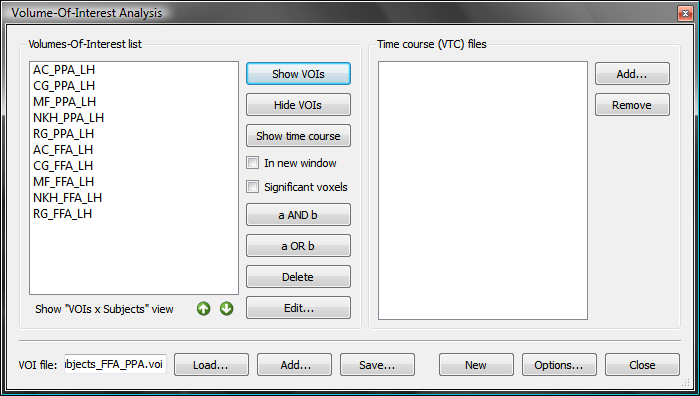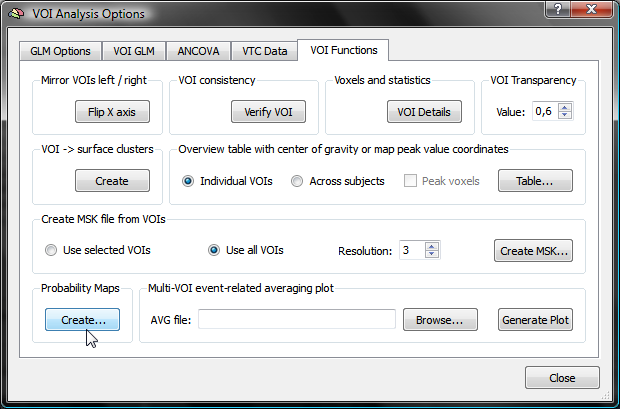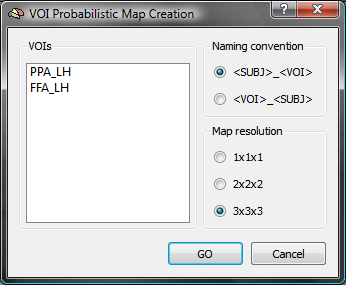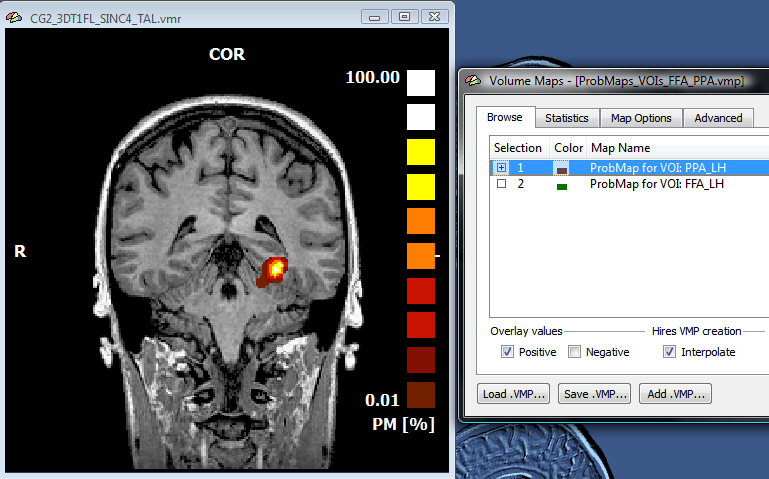BrainVoyager QX v2.8
Probabilistic Maps from Volumes-Of-Interest
Probabilistic maps can be calculated from Volumes-Of-Interest (VOIs) defined for each subject in Talairach space. The probabilistic map then reveals how consistent a homologue region is located across subjects. These homologue regions may be functionally defined areas, but may also be derived from other information, e.g. macro-anatomical areas.
In order to use the probabilistic map tool, the VOIs must be defined for one or more areas for each subject participating in a group analysis. The VOI names must uniquely identify the subject as well as the area. The names of the VOIs must follow the naming convention "[Subject-ID]_[Region]" or "[Region]_[Subject-ID]"; you may choose one of these naming conventions but it must be applied consistently across subjects. While the "Region" name may contain underscore ("_") symbols, the subject identifier may not contain this symbol because it is used to split the subject identifier from the region name.

The snapshot above shows the Volume-Of-Interest Analysis dialog filled with 10 VOIs. The naming convention is used with the subject identifier at the beginning of the VOI name. An explicit representation of the extracted region and subject names can be obtained by clicking the Show VOIs x Subjects view button. In this example, the subject identifiers are "AC", "CG", "MF", "NKH" and "RG" and the region names are "FFA_LH" and "PPA_LH". A separate probabilistic map can be calculated for each of these two regions across the five involved subjects.

In order to specify the region(s) for which probabilistic maps should be calculated, click the Create button in the VOI Functions tab of the VOI Analysis Options dialog (see snapshot above). This invokes the VOI Probabilistic Map Creation dialog shown below.

The VOIs list in the dialog shows all available homologue regions without the subject identifiers (in the example the two regions "FFA_LH" and "PPA_LH"). In case that subject names are shown, the naming convention does not match; to adjust to the chosen naming convention, click the VOI_SUBJ option in the Naming convention field. The calculated probabilistic map will be stored in a native-resolution volume map allowing to use different voxel resolutions. Since VOIs are ususally defined on VMRs with a resolution of 1 (Talairach) mm, you may want to select the 1x1x1 option in the Map resolution field. The default resolution for (functional) volume maps uses a voxel resolution of 3, i.e. one functional voxel represents 3x3x3 = 27 anatomical voxels.
After selecting one (or more) VOIs in the VOIs list, click the GO button, which will calculate a separate probabilistic map for each selected VOI. To select which calculated probabilistic map should be overlaid on the anatomical VMR data set, open the Volume Maps dialog, which will show an entry in the Maps list for each created probabilistic map. For the example data, both VOIs had been selected resulting in two probabilistic maps; note that the names of the maps contain the VOI name allowing to identify the maps in case that more than one has been calculated. In the snapshot below, the first probabilistic map (for area "PPA_LH") has been selected and the overlay on a coronal slice is shown on the left side.

More than one map can be selected for overlay at the same time but this requires switching to the Multiple selections option in the Map Selection field of the Advanced tab of the dialog. Furthermore, an individual overlay look-up table (OLT) may be assigned for each map using the Browse LUT button in the Value and color ranges field of the Statistics tab of the Volume Maps dialog.
Copyright © 2014 Rainer Goebel. All rights reserved.